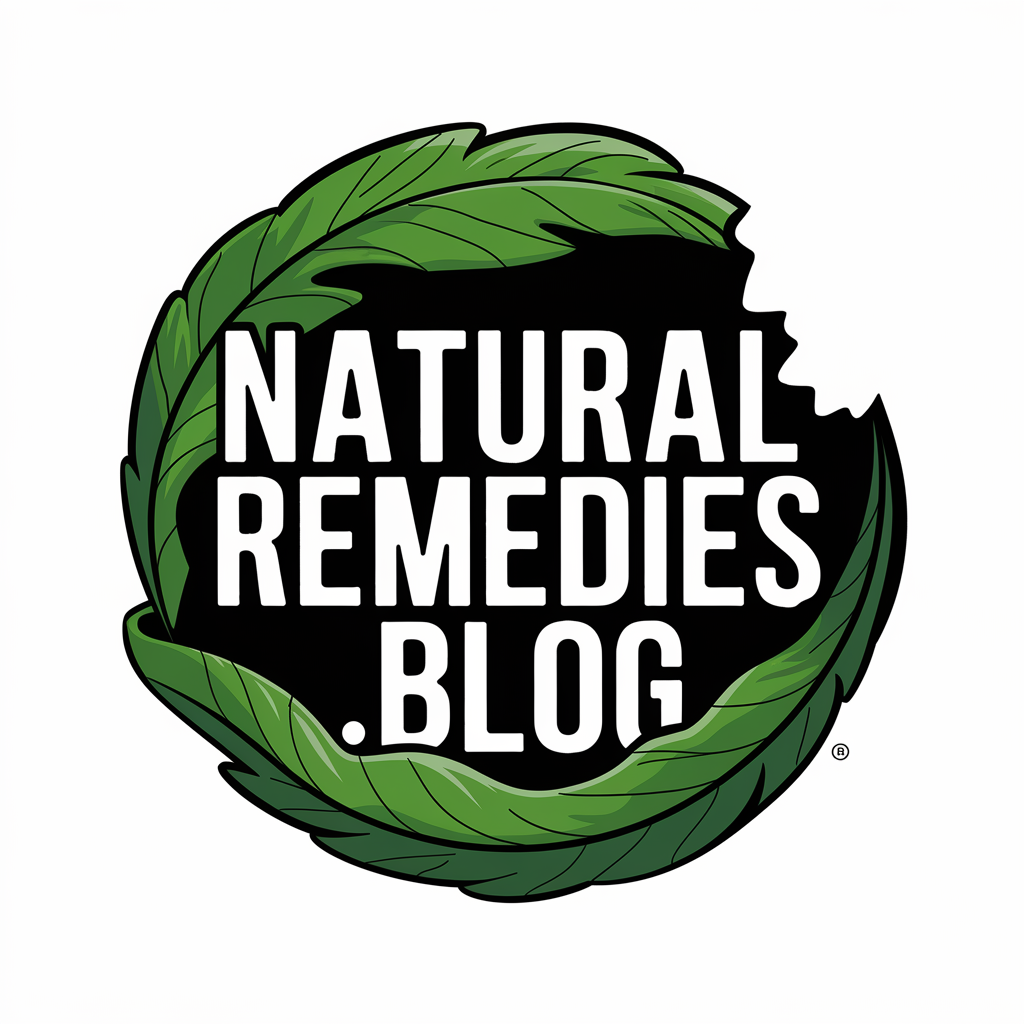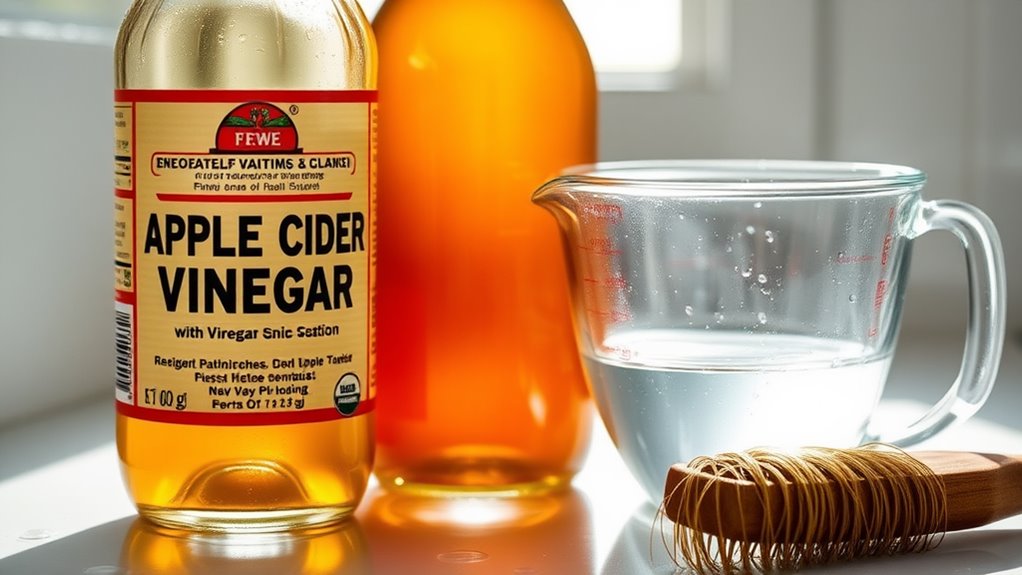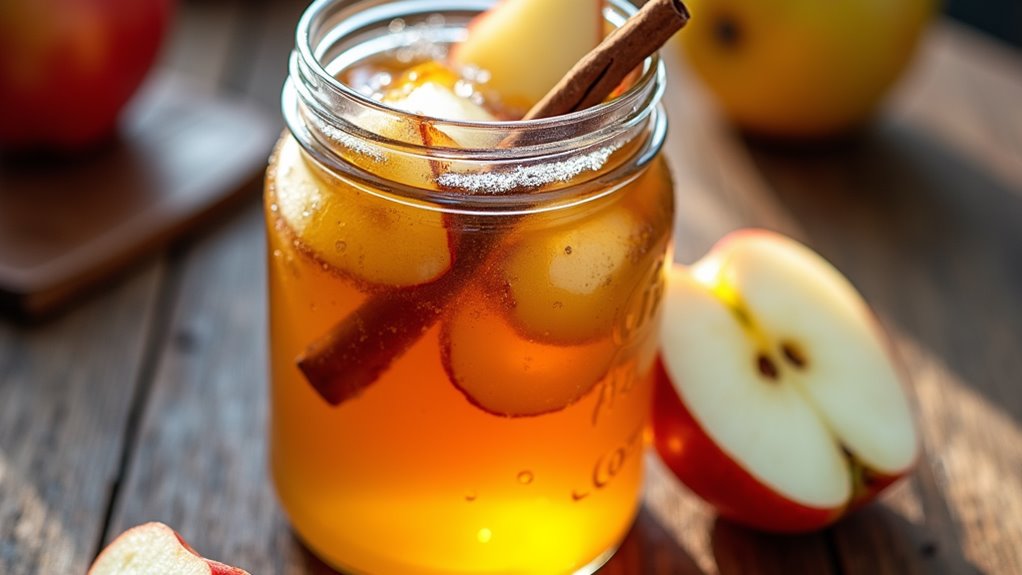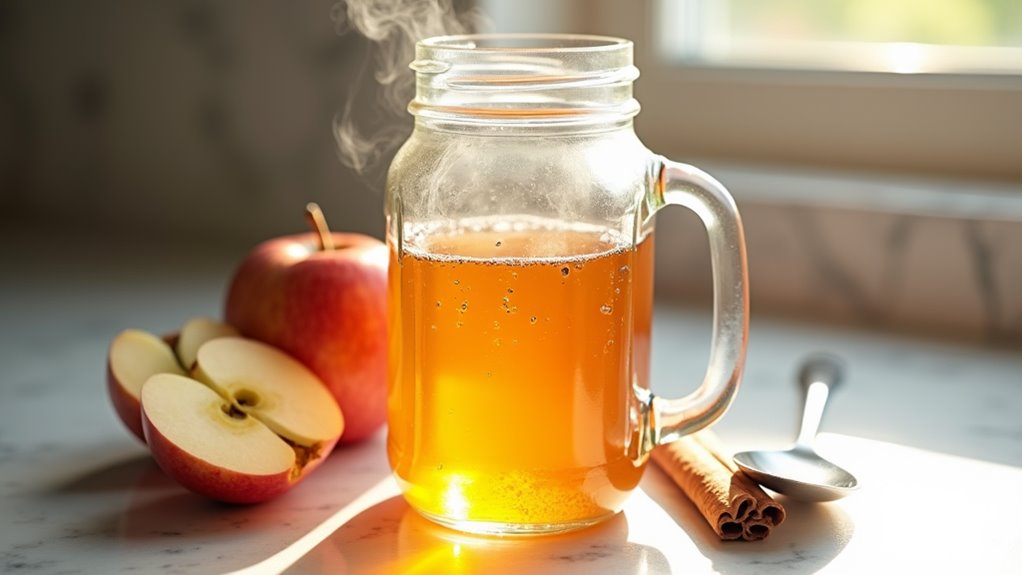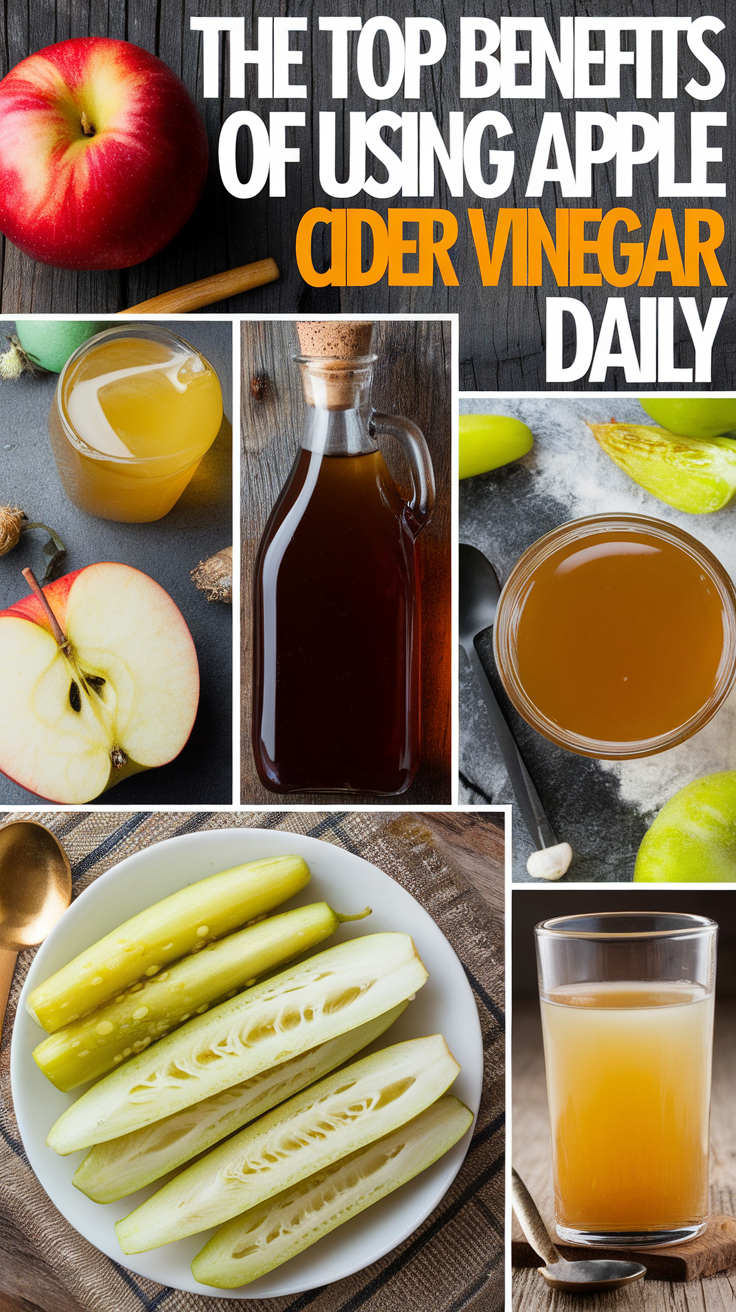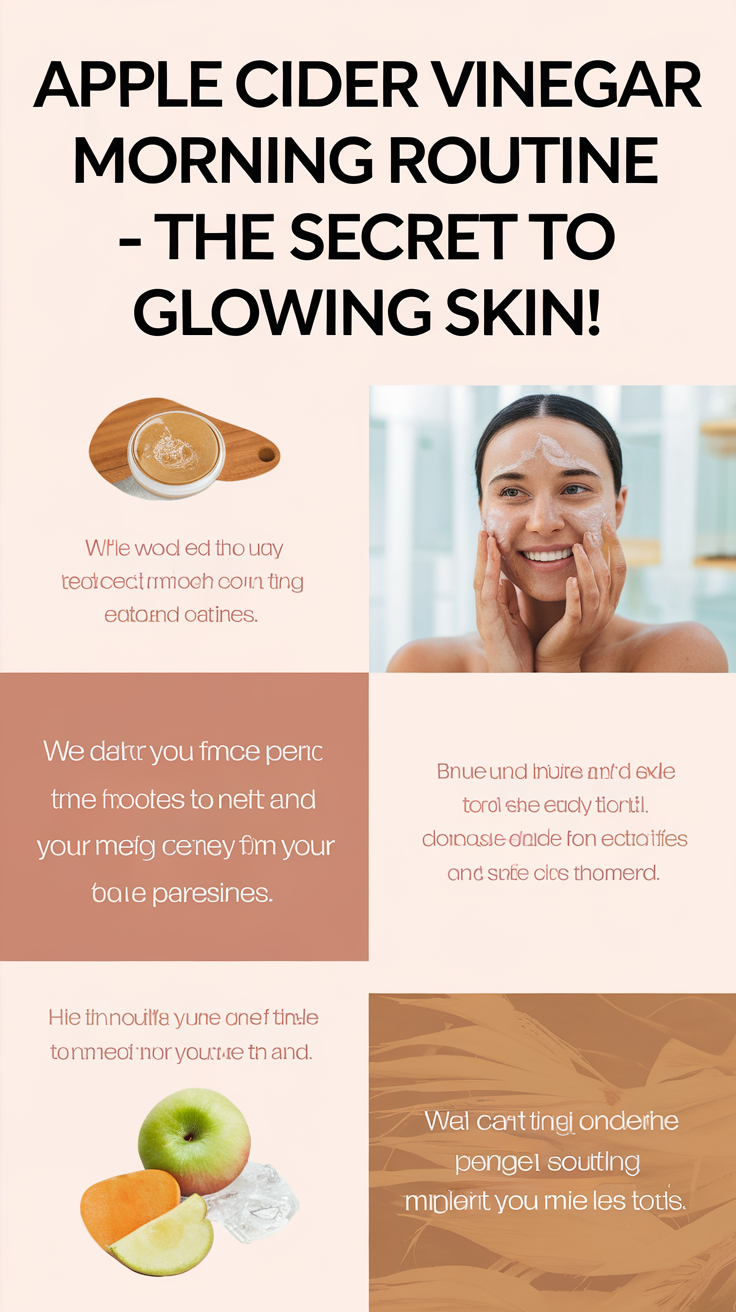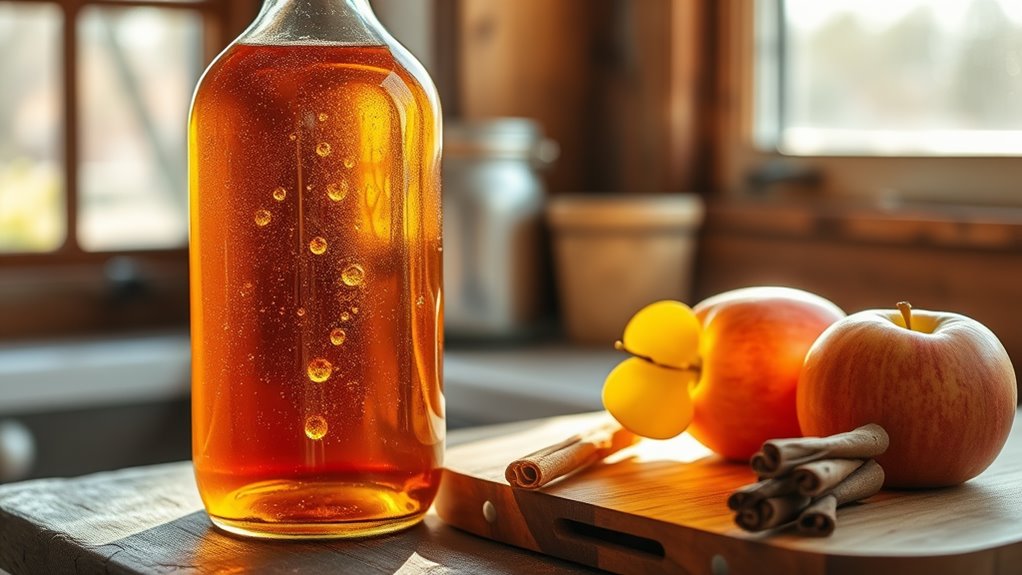Apple Cider Vinegar for Hair Rinse- Does It Work.
Apple cider vinegar (ACV) hair rinses do work when properly diluted and applied. The acetic acid in ACV effectively balances your scalp’s pH to the ideal 4.5-5.5 range, while its antimicrobial properties combat fungi and bacteria that cause dandruff. You’ll notice reduced buildup, decreased frizz, and enhanced shine within 2-4 weeks of twice-weekly treatments. For best results without irritation, you’ll need to understand the precise ratios and application methods for your specific hair type.
The Science Behind ACV Hair Benefits
The science behind apple cider vinegar’s hair benefits centers on its unique chemical properties and interactions with the scalp ecosystem.
When you use an apple cider vinegar hair rinse, its acetic acid content (pH 2-3) helps normalize your scalp and hair’s pH levels to the ideal range of 4.5-5.5. This pH balancing effect smooths your hair cuticles, increases shine, and reduces frizz. ACV’s chemical composition of fermented apple sugars produces beneficial compounds through the two-stage fermentation process. Additionally, its antimicrobial properties can help combat dandruff-causing fungi and bacteria, promoting a healthier scalp environment.
Research confirms ACV’s antimicrobial properties against common scalp pathogens like Candida albicans, though it’s worth noting these benefits are primarily surface-level and don’t extend to significant hair growth or loss prevention.
How ACV Restores Hair and Scalp Health
While scientific evidence remains limited, apple cider vinegar can help restore hair and scalp health through several key mechanisms.
The acidic nature of ACV helps balance your hair’s pH levels, potentially improving strength and shine. Mixing with yeast and carbohydrates, ACV undergoes fermentation to create its beneficial properties. Additionally, its antimicrobial properties can combat minor scalp infections and reduce itchiness.
When combined with recognized treatments like minoxidil, ACV may enhance their absorption and effectiveness. While it won’t directly stimulate hair growth, it can cleanse your scalp of product buildup and excess oil.
However, you’ll need to dilute ACV properly to avoid irritation and make sure you’re using it as part of a thorough hair care routine.
DIY ACV Hair Rinse Recipe and Application
When crafting your ACV hair rinse, combine raw, unfiltered apple cider vinegar with water in a 1:4 ratio to maintain a safe pH level for your scalp and hair. This natural rinse not only helps promote healthy hair growth but also enhances shine and smoothness. You’ll want to apply the mixture to freshly shampooed hair, focusing on your scalp while gently massaging for 1-2 minutes to stimulate circulation and enhance absorption. For best results and safety, always perform a patch test before full application, and limit usage to once or twice weekly to prevent potential scalp irritation or hair dryness. Thoroughly rinse out the mixture with cool water after letting it sit for up to 10 minutes to avoid any potential irritation from overexposure.
Basic Recipe Steps
Making an effective apple cider vinegar hair rinse requires three essential components: raw, unfiltered ACV, clean lukewarm water, and precise measurements.
Start by combining 1/4 cup of raw ACV with 1 cup of lukewarm water in a glass or plastic spray bottle. The 5% acetic acid content in ACV makes this dilution ratio safe and effective for hair use.
This 1:4 ratio optimizes the solution’s pH-balancing properties while preventing scalp irritation.
For enhanced therapeutic benefits, you can incorporate 1-2 drops of essential oils like rosemary or lavender.
Shake the mixture thoroughly to guarantee proper distribution of ingredients.
Store your rinse in a cool, dark place, and always perform a patch test before full application.
Application and Safety Tips
Although applying an apple cider vinegar hair rinse requires precision, you’ll achieve best results by following specific safety protocols and application techniques.
After shampooing, pour your pre-mixed solution of 2-4 tablespoons ACV with 16 ounces of cool water over your wet hair, focusing on the scalp.
Using a scalp massager tool can help effectively loosen product buildup during application.
Massage gently for even distribution, and let it sit for 2-3 minutes.
Always use plastic or glass containers, as metal can react with vinegar.
Rinse thoroughly with cool water to seal cuticles.
Perform this treatment only 1-2 times weekly to prevent pH disruption. Test on a small patch first, and discontinue if irritation occurs.
Best Practices for Safe ACV Hair Treatment
Since apple cider vinegar’s acidic properties can affect your scalp’s pH balance, following proper safety protocols is essential for an effective hair treatment.
Always dilute 2-4 tablespoons of ACV in 16 ounces of cool water before application. This dilution process helps mitigate potential scalp irritation while maximizing benefits.
Apply the mixture after shampooing, leaving it on for 1-2 minutes before thoroughly rinsing.
Limit treatments to once or twice weekly to prevent scalp irritation. Frequent use may disrupt your scalp’s natural balance.
If you experience any discomfort, rinse immediately and discontinue use.
Raw, unfiltered ACV containing the mother offers additional probiotic benefits for your scalp and hair health.
For enhanced safety and convenience, consider professional ACV-based products that combine the vinegar with complementary ingredients.
Results and Benefits to Expect
When you follow proper ACV hair rinse protocols, you’ll begin noticing multiple benefits within 2-4 weeks of consistent use.
You’ll experience decreased buildup as ACV dissolves product residue and mineral deposits.
Your hair’s natural pH will rebalance, leading to sealed cuticles, reduced frizz, and enhanced shine.
The antimicrobial properties will improve your scalp health, potentially reducing dandruff and inflammation.
You’ll notice improved manageability, volume, and texture as your hair becomes clarified.
While direct hair growth stimulation isn’t guaranteed, the improved scalp environment and strengthened strands will support healthier growth cycles. Additionally, the antimicrobial properties of ACV can further enhance your hair’s overall health and vitality.
Common Mistakes to Avoid With ACV Rinses
Despite the benefits of apple cider vinegar hair rinses, improper application can lead to scalp irritation, hair damage, and ineffective results.
Never apply undiluted ACV directly to your scalp, as its high acidity can cause significant irritation. The acetic acid in ACV is a key component that can contribute to irritation if used improperly.
Don’t leave the solution on for extended periods or use it daily.
Instead, properly dilute ACV and consider your hair’s porosity and scalp sensitivity.
Monitor for adverse reactions and always follow up with moisturizing treatments.
Remember that ACV isn’t a miracle solution for hair growth but rather a clarifying treatment. Research shows that ACV combined with minoxidil can increase absorption by 41.6% for those using hair growth treatments.
Adjust frequency based on your hair type, and maintain pH balance by alternating with gentle, pH-neutral products.
References
- https://www.healthline.com/health/apple-cider-vinegar-hair
- https://www.medicalnewstoday.com/articles/319396
- https://health.unl.edu/apple-cider-vinegar-good-your-skin-and-hair/
- https://hairlust.com/blogs/blog/acv-for-scalp-and-hair
- https://www.girlandhair.com/products/apple-cider-vinegar-hair-rinse
- https://wimpoleclinic.com/blog/apple-cider-vinegar-for-hair-loss-evidence-review/
- https://pmc.ncbi.nlm.nih.gov/articles/PMC8706394/
- https://hairstory.com/blogs/news/apple-cider-vinegar-good-for-hair
- https://www.verywellhealth.com/apple-cider-vinegar-hair-rinse-8733422
- https://www.hollandandbarrett.com/the-health-hub/natural-beauty/haircare/apple-cider-vinegar-hair-rinse/
